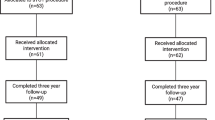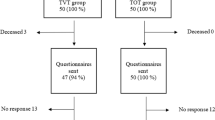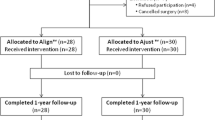Abstract
Introduction and hypothesis
Stress urinary incontinence (SUI) is the involuntary loss of urine on effort and is a condition that negatively interferes with various aspects of a woman’s life. This study aimed to demonstrate the non-inferiority of the less invasive single-incision mini-sling (SIMS) method in objective and subjective cures in relation to tension-free transobturator tape (TOT) in two analyses, per protocol and intention to treat, and secondarily to evaluate complications and quality of life.
Methods
This study was a randomized controlled trial (RCT). Participants in this study included 105 women with a clinical diagnosis of stress predominant urinary incontinence and urodynamic results demonstrating SUI and absence of detrusor overactivity. Patients were evaluated pre- and postoperatively through anamnesis, physical examination, urinalysis, urine culture and susceptibility testing, simplified pad test, the Urinary Incontinence-Specific Quality of Life Instrument (I-QOL) and Urogenital Distress Inventory Short Form (UDI-6).
Results
Regarding the objective cure, SIMS was non-inferior to TOT (p < 0.05). However, the same was not found for the subjective cure (p > 0.05). There were no differences in the complication rates (p > 0.05). However, in the TOT group, bladder perforation (2.4%), tape exposure (2.4%) and urinary retention occurred, lasting > 7 days (2.4%). In both groups, there was improvement in quality of life after surgery, without significant differences (p > 0.05).
Conclusions
The non-inferiority of SIMS in relation to TOT was only demonstrated in the objective cure. There were no significant differences between groups regarding complications and quality of life.

Similar content being viewed by others
References
Haylen BT, de Ridder D, et al. An International Urogynecological Association (IUGA)/International Continence Society (ICS) joint report on the terminology for female pelvic floor dysfunction. Int Urogynecol J. 2010;21(1):5–26.
Karbage SAL, Santos ZMSA, Frota MA, et al. Quality of life of Brazilian women with urinary incontinence and impact on their sexual function. Eur J Obstet Gynecol Reprod Biol. 2016;201:56–60. https://doi.org/10.1016/j.ejogrb.2016.03.025.
Barentsen JA, Visser E, Hofstetter H, et al. Severity, not type, is the main predictor of decreased quality of life in elderly women with urinary incontinence: a population-based study as part of a randomized controlled trial in primary care. Health Qual Life Outcomes. 2012;10:153. https://doi.org/10.1186/1477-7525-10-153.
Wood LN, Anger JT. Urinary incontinence in women. BMJ. 2014;349:g4531. https://doi.org/10.1136/bmj.g4531.
Kowalik CG, Dmochowski RR, De EJB. Surgery for female SUI: the ICI algorithm. Neurourol Urodyn. 2019. https://doi.org/10.1002/nau.23879.
Petros PE, Ulmsten UI. An integral theory and its method for the diagnosis and management of female urinary incontinence. Scand J Urol Nephrol Suppl. 1993;153:1–93.
Ulmsten U, Henriksson L, Johnson P, et al. An ambulatory surgical produce under local anestesia for treatment of female urinary incontinence. Int Urogynecol J. 1996;7:81–6.
Nilsson CG, Palva K, Rezapour M, et al. Eleven years prospective follow-up of TVT produce treatment of stress urinary incontinence. Int Urogynecol J. 2008;19:1043–7.
Deng DY, Rutman M, Raz S, et al. Presentation and management of major complications of midurethral slings: are complications under-reported? Neurourol Urodyn. 2007;26:46–52.
Delorme E. Transobturator urethral suspension: mini-invasive procedure in the treatment of stress urinary incontinence in women. Prog Urol. 2001;11(6):1306–13.
de Leval J. Novel surgical technique for the treatment of female stress urinary incontinence: transobturator vaginal tape inside-out. Eur Urol. 2003;44:724–30.
Seklehner S, Laudano MA, Xie D, et al. A meta-analysis of the performance of retropubic mid urethral slings versus transobturator mid urethral slings. J Urol. 2015;193(3):909–15. https://doi.org/10.1016/j.juro.2014.09.104.
Cox A, Herschorn S, Lee L. Surgical management of female SUI: is there a gold standard? Nat Rev Urol. 2013;10(2):78–9. https://doi.org/10.1038/nrurol.2012.243.
Ford AA, Rogerson L, Cody JD, et al (2017) Mid-urethral sling operations for stress urinary incontinence in women. Cochrane Database Syst Rev 7:CD006375. https://doi.org/10.1002/14651858.CD006375.pub4.
Molden SM, Lucente VR. New minimally invasive slings: TVT Secur. Curr Urol Rep. 2008;9:356–61.
Palma P, Riccetto C, et al. What is the best indication for single-incision Ophira mini sling? Insights from a 2-year follow-up international multicentric study. Int Urogynecol J. 2014;25(5):637–43.
Wu WY, Sheu BC, Lin HH. Comparison of 20-minute pad test versus 1-hour pad test in women with stress urinary incontinence. Urology. 2006;68(4):764–8.
Uebersax JS, Wyman JF, Shumaker SA, et al. Short forms to assess life quality and symptom distress for urinary incontinence in women: the incontinence impact questionnaire and the urogenital distress inventory. Continence program for women research group. Neurourol Urodyn. 1995;14(2):131–9.
Souza CC, Rodrigues AM, Ferreira CE, et al. Portuguese validation of the urinary incontinence - specific quality-of-life instrument: I-Qol. Int Urogynecol J Pelvic Floor Dysfunct. 2009;20:1183–9.
Djehdian LM, Araujo MP, Takano CC, Del-Roy CA, Sartori MG, Girão MJ, et al. Transobturator sling compared with single-incision mini-sling for the treatment of stress urinary incontinence: a randomized controlled trial. Obstet Gynecol. 2014;123(3):553–61.
Hagan KA, Erekson E, et al. A prospective study of the natural history of urinary incontinence in women. Am J Obstet Gynecol. 2018;218(5):502.e1–8.
Lamerton TJ, Torquati L, Brown WJ. Overweight and obesity as major, modifiable risk factors for urinary incontinence in young to mid-aged women: a systematic review and meta-analysis. Obes Rev. 2018;19(12):1735–45.
Ashton-Miller JA, DeLancey JO. Functional anatomy of the female pelvic floor. Ann N Y Acad Sci. 2007;1101:266–96.
Yuksel MB, Kose O, Karakose A, et al. The comparison of short term results of transobturatour tape and single incision midurethral sling procedures. Int J Women’s Health Reprod Sci. 2013;1(3):80–7. https://doi.org/10.15296/ijwhr.2013.14.
Schellart RP, Oude Rengerink K, Van der Aa F, et al. A randomized comparison of single-incision midurethral sling in women with stress urinary incontinence: results of 12-mo follow-up. Eur Urol. 2014;66(6):1179–85. https://doi.org/10.1016/j.eururo.2014.07.027.
Nambiar A, Cody JD, Jeffery ST, et al. Single-incision operations for urinary incontinence in women. Cochrone Database Syst Rev. 2017;7:CD008709. https://doi.org/10.1002/14651858.CD008709.pub3.
Staat M, Trenz E, Lohmann P. New measurements to compare soft tissue anchoring systems in pelvic floor surgery. J Biomed Mater Res B Appl Biomater 2012.
Zhang P, Fan B, Zhang P, et al. Meta-analysis of female stress urinary incontinence treatments with adjustable single-incision mini-slings and transobturator tension-free vaginal tape surgeries. BMC Urol. 2015;15:64. https://doi.org/10.1186/s12894-015-0060-3.
Siddiqui NY, Wiseman JB, Cella D, et al. Mental health, sleep, and physical function in treatment-seeking women with urinary incontinence. J Urol. 2018;200(4):848–55.
Oliveira R, Botelho F, Silva P, et al. Single-incision sling system as primary treatment of female stress urinary incontinence: prospective 12 months data from single institution. BJU Int. 2011;108(10):1616–21. https://doi.org/10.1111/j.1464-410X.2011.10158.x.
Hillary CJ, Osman N, Chapple C. Considerations in the modern management of stress urinary incontinence resulting from intrinsic sphincter deficiency. World J Urol. 2015;33(9):1251–6. https://doi.org/10.1007/s00345-015-1599-z.
Spelzini F, Frigerio M, Regini C, Palmieri S, Manodoro S, Milani R. Learning curve for the single-incision suburethral sling procedure for female stress urinary incontinence. Int J Gynaecol Obstet. 2017;139(3):363–7.
Montera R, Plotti F, Ricciardi R, et al. Learning curves of a resident surgeon performing transobturator tape procedures for stress urinary incontinence. Int J Gynaecol Obstet. 2016;134(3):345–9. https://doi.org/10.1016/j.ijgo.2016.02.017.
Rehman H, Bezerra CA, Bruschini H, et al. Tradicional suburethral sling operations for urinary incontinence in women. Cochrane Database Syst Rev. 2017;7:CD001754. https://doi.org/10.1002/14651858.CD001754.pub4.
Palos CC, Maturana AP, Ghersel FR, et al. Prospective and randomized clinical trial comparing transobturator versus retropubic sling in terms of efficacy and safety. Int Urogynecol J. 2018;29(1):29–35.
Taner CE, Okay G, Göklü Y, et al. Perioperative and postoperative complications after Ophira mini sling operations. Arch Gynecol Obstet. 2015;291(2):341–6. https://doi.org/10.1007/s00404-014-3402-6.
Author information
Authors and Affiliations
Corresponding author
Ethics declarations
Conflicts of interest
The authors declare that they have no conflict of interest.
Additional information
Publisher’s note
Springer Nature remains neutral with regard to jurisdictional claims in published maps and institutional affiliations.
Rights and permissions
About this article
Cite this article
Maturana, A.P., Palos, C.C., Ghersel, F.R. et al. Randomized controlled trial comparing mini-sling with transobturator sling for the treatment of stress urinary incontinence. Int Urogynecol J 31, 1925–1931 (2020). https://doi.org/10.1007/s00192-019-04145-y
Received:
Accepted:
Published:
Issue Date:
DOI: https://doi.org/10.1007/s00192-019-04145-y




